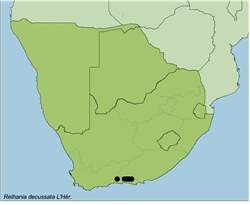Names and synonyms
Relhania decussata L'H�ritier
=Eclopes decussata (L'Herit.) DC. (excl. descr. = R. uniflora (L.f.) Druce)
=Relhania patersoniae L. Bolus
Type
Masson, F., Promont B. Spei (BM)
Derivation of names
Relhania = after Irish-born Richard Relhan (1754-1823), botanist, plant collector, bryologist, lichenologist, one of the founders of the Linnean Society, rector in Lincolnshire and author of Flora Cantabile.
decussata = decussate, with each pair of opposite leaves at right angles to the one below
Diagnostic characters
Leaves sickle-shaped or straight, smooth, triangular in cross section, woolly above but surface hidden
Leaves usially 4-ranked, giving the stem and leaves a 'vierkantige' appearance
Capitula solitary, funnel-shaped
Involucral bracts acute, brown with a narrow membranous margin
Description
A sparsely branched shrublet, 0.2-0.6 m high. Stems ascending-erect, glabrous, leafy, becoming nude and marked with leaf-scars. Leaves decussate, in four indistinct rows, spreading, canaliculate with involute margins, somewhat incurved, narrowly triangular, 3-10 x 1-1.5 mm, glabrous and transversely rugulose dorsally, densely lanate and whitish above, acute, pungent. Capitula solitary, sessile, terminal. Involucre bell-shaped, 6-15 mm wide. Involucral bracts 40-60, outer ovate, inner gradually longer and elliptic, innermost narrowly oblong, up to 17 x 3 mm, dark brown with pale and scarious margins, acute. Receptacle flat-convex, paleate. Paleae flat or slightly canaliculate, linear, 6-9 x 0.6-1 mm, dorsally sparsely gland-dotted, acute. Ray florets 14-35, tube 2.5-3.5 mm long, lamina narrowly elliptic, 11-15 x 2-3 mm, 4-veined, orange-yellow, often reddish below. Disc florets >50, perfect, dorsally � gland-dotted, orange-yellow. Pappus crownlike, of � connate scales, up to 1 mm long. Cypsela somewhat triquetrous, elliptic-oblong, 2-2.5(-3) x 0.6-0.9 mm, glabrous or villose in ray florets.
Flowering time
Mainly from September to November.
Distribution
Eastern Cape, where it has been reported from Baviaanskloof, Blesberg, Slypsteenberg, Antoniesberg, Kouga Mts. and, Tsitsikamma Mts.
Known from 16 specimens.
Habitat
Rocky and stony mountain slopes, on lower foothills as well as the crest of mountains, also on vertical cliffs.
Notes
This is an easily recognised species with characteristic foliage and conspicuous, brown involucres. It is probably related to the group of species with many-nerved leaves and large capitula.
References
BREMER, K. 1976. The genus Relhania (Compositae). Opera Botanica 40.
GLEN, H.F. 2004. SAPPI, What's in a Name? The Meanings of the Botanical Names of Trees. Jacana.
KESTING, D. & CLARKE, H. 2008. Botanical names, what they mean. Wild Flowers of the Cape Peninsula, 3rd revised edition. Friends of Silvermine.
